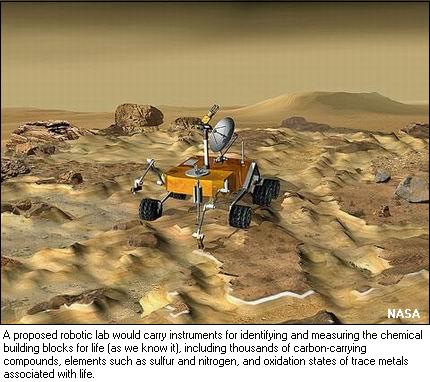
|
|

|
|
| April 25, 2024 |
|
Looking for ET 
HOUSTON, TX--They still haven't found any Martian microbes, or telltale signs of alien biospheres orbiting distant stars. But scientists looking for signs of life in our solar system and the universe beyond are not discouraged.
Researchers at the biennial Astrobiology Science Conference described a series of ambitious new projects they say will continue the search for extraterrestrial life. Search for Extraterrestrial Life Among them was Cornell University researcher Steve Squires, chief scientist on the Mars Rover Mission for NASA. In a news briefing he told reporters that astrobiology will be central to future space exploration. "NASA is currently considering 28 different missions. They are sort of breathtaking in their sweep. They cover everything from Mercury landers to fly-bys of objects in the deep outer solar system." Squires says one of the most ambitious endeavors is a Mars Sample Return Mission, which would retrieve rocks and soil from the Martian surface in three stages. A robotic ranger would collect samples. A lander would pick them up and then rendezvous with an orbiter to bring them back to Earth. The project has been on the drawing boards for 20 years, but never acted on. But the search for life, Squires suggests, is a long-term effort. "What we're saying is that it is possible to string those out in time, with gaps of potentially years. And what that does is that it makes the overall program more affordable because it spreads the cost out over time." Exploration Other astrobiology projects in the works include unmanned interplanetary orbiters that would use ice penetrating radar to look for a liquid ocean under the icy surface of Jupiter's moon, Europa, and to explore the methane lakes on Titan, a moon of Saturn. The search for extraterrestrial life actually involves some Earth-centered science, too. University of California Los Angeles paleobiologist Bill Schopf studies the oldest fossils on earth. He presented new data at the Astrobiology Science Conference that shows diverse micro-fossils found in a layer of gypsum in a 6 million-year-old Mediterranean Sea bed. Schopf says orbital mapping also shows similar mineral deposits on Mars. "We now know that this is a good place to look for evidence of fossil life on Mars, but I think that also you might see clumps of organic material and that would be a real good finding on Mars because if we can find the organic matter, then we have a real reason to think that there might once have been life there." Life on Mars As luck would have it, the Mars rover, named Opportunity, landed on a field of gypsum, or calcium sulfate six years ago. NASA's Steve Squires says Mars rocks and soil could yield valuable clues to ancient forms of life. "We know there are iron sulfates, magnesium sulfates and calcium sulfates. Gypsum is a calcium sulfate. All of those are present at the Opportunity landing site." UCLA professor Bill Schopf is anxious to analyze those Martian sulfates for signs of life. "I think that if we had the rocks back tomorrow morning, and I had them in my lab, I think we could solve this problem. Squires says the discovery of water and organic materials - the building blocks of life as we know it on Earth, will be top priorities on NASA's future deep-space missions. (Source: voanews.com) Story Date: May 5, 2010
|